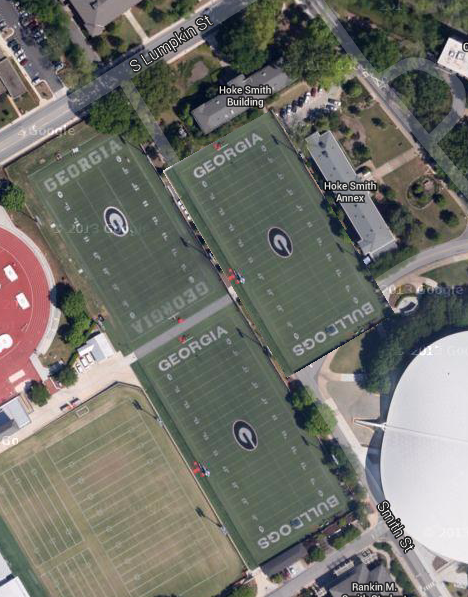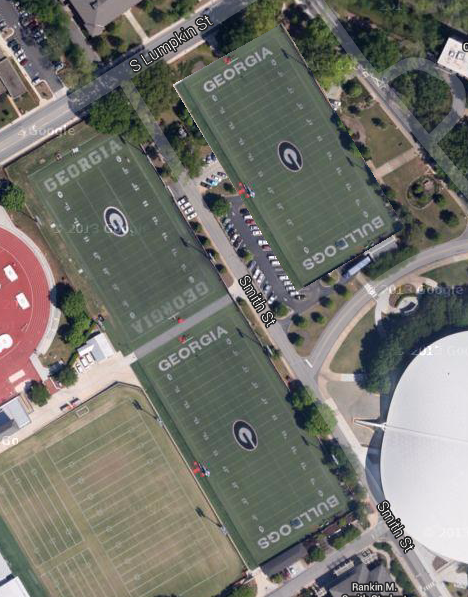[See Georgia’s 2015 signing class here.]
Overall
Take a step back for a second – in the past year, Georgia has replaced both coordinators and the entire defensive coaching staff. Only Mark Richt and three offensive position coaches remain from the 2013 season. On the field Georgia weathered the first stage of that transition in 2014 with a 10-win season and a top-10 final ranking. On the recruiting trail, Georgia might’ve fared even better. Despite losing longtime offensive coordinator (and perhaps the program’s best recruiter) Mike Bobo, Georgia held on to and even added to an outstanding 2015 recruiting class. Georgia’s new coaches have put together consecutive consensus top-10 recruiting classes, and Wednesday’s large (and perhaps soon to be even larger) group replenishes the roster at several positions.
Needs
I sat at the Blind Pig facing their list of signees, and the emphasis of the class was hard to miss. The half of the list dedicated to the offense had a blank column big enough to write Terry Godwin’s name vertically while the defensive side had run out of space. About two-thirds of Georgia’s class are defenders, and the team addressed areas on defense hit by graduation as well as areas that needed shoring up.
The class is strongest on the defensive line. Georgia signed not only defensive tackles (Trenton Thompson could have immediate impact), but there are also several guys who could be effective 3-4 defensive ends. The class was a little thin at linebacker with only a trio signed (pending Roquan Smith), but one of the cardinal rules of recruiting is to avoid getting hung up over a player’s stated position. We’ll see how the pieces are plugged into the roster down the road. The secondary, though losing only Swann, had to replace a slew of transfers and added signees both at cornerback and safety. Several will have an opportunity to have the immediate impact that Dominick Sanders had in 2014.
Georgia’s haul on offense was lighter, but you still see areas of focus. The Dawgs didn’t sign a quarterback, and the only backfield signee was a late addition more in the mold of Quayvon Hicks than a true tailback. Georgia got an outstanding tight end, bolstered the receivers, and four offensive linemen ranging from 6’4″ to 6’7″ give the team a head start on replacing the group that will be graduating after 2015. 5* athlete Terry Godwin gives Georgia another versatile weapon to go along with Michel, McKenzie, and Mitchell.
With a class of around 30 players, it’s hard to say that any areas of need were left wanting. Georgia is committed to the quarterbacks on the roster knowing that the nation’s best quarterback is on his way in 2016. Likewise, Georgia will ride with the five returning scholarship tailbacks and address the future of that position in 2016. You might have liked a little more help at inside linebacker with Herrera and Wilson departing, but we’ll see how the staff distributes the roster in August, and UAB standout Jake Ganus could help.
Walk-ons
Californian Nick Robinson will join the team as a quarterback. U.S. Army All-American kicker Rodrigo Blankenship will walk on until a scholarship becomes available in 2016 when he’ll be the leading candidate to replace Marshall Morgan. Hudson Reynolds of Bainbridge could very well become the next long-snapper once Theus graduates.
Immediate Impact
Where does the large 2015 class have the best opportunity to get on the field? You can start with Trenton Thompson. The dominant lynchpin of Georgia’s defensive line class will be an important part of the rotation right away. We’ll likely see other true freshmen join Tracy Rocker’s rotation. It will also be hard to keep Godwin off the field – as we saw with Michel and McKenzie in 2014, a creative offensive coordinator should get playmakers involved even as true freshmen. Depending on the health of Jay Rome, tight end Jackson Harris could be next in line behind Blazevich. The most intriguing area might be the secondary – the 2014 unit was largely improvised with changing lineups and walk-ons and true freshmen pressed into service. Some like Sanders and Mauger made enough progress to be considered returning starters, but there’s a whole lot of playing time up for grabs.
Kirby Choates
We’ve all heard the fans who claim to prefer lower-rated prospects who bleed red and black over the 5* guy making a business decision. Often that’s just a form of sour grapes and has always struck me as odd – why not prefer 25 5* guys whose parents named them “Herschel?” That’s a roundabout way of getting to Kirby Choates Jr. Choates, a “self-professed longtime Bulldog fan,” was off the radar for most of the process while he worked to become academically qualified. Even once he cleared up academic concerns, it was touch and go whether Georgia’s class had filled up. The offer he had waited for finally came, and his signing ceremony tells you everything you need to know about what the opportunity to play at Georgia means to him. It’s unfair to make Tim Jennings (another unheralded 11th hour offer) comparisons, but we do know that Kirby Choates will have a lot of fans in his corner when he arrives in Athens.
Roquan Smith
Smith’s story became an instant Signing Day classic – the surprising announcement, the wait while he put the UCLA gloves on, and then the excitement that circulated as rumors of second thoughts spread. Georgia’s top signee, Trenton Thompson, became involved. Then news hit that his would-be coordinator at UCLA was going to become part of the Atlanta Falcons staff. The day ended not with a reversal but with a step back to reconsider all four of his finalists.
We were reminded that Signing Day isn’t a day – the 2015 football signing period goes through April 1. For his own sake, I’m glad that he didn’t rush into following through on a very public announcement if he still had doubts. The confusion over the UCLA coaching decision showed that he made the right decision to wait.
As a Georgia fan, of course I want Smith in Athens. His talent is without question, and he plays at a position of need for Georgia. He’s feeling the stress and weight of a bigger decision than most of us had faced at that age, and the pressure from friends and family to stay home can be both a positive and a negative. I think Tyler has a good insight here – I hope those bridges can be rebuilt as Smith reconsiders his decison.
 UGA and UNC to open the 2016 season in Atlanta
UGA and UNC to open the 2016 season in Atlanta



 Dawg Media
Dawg Media